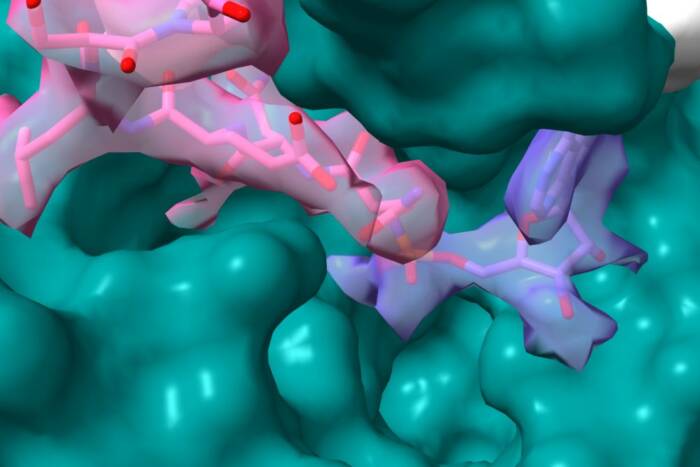Genetic clues to stem cells' unlimited potential
Rockefeller research team completes first map of human embryonic “stemness”
As an embryologist, Ali H. Brivanlou wants to know every genetic route taken by a small mass of undifferentiated, or unformed, embryonic cells as they develop into an organism.
Now he knows. The first atlas, or map, of genes associated with early human development was published on-line this week in Developmental Biology. With Brivanlou at the lead, a group of molecular vertebrate embryologists and statisticians at The Rockefeller University created the guide, which will be systematically used to study human development and the potential clinical usefulness of human embryonic stem cells. The publication will appear in print on August 15.

Collecting data from mouse and human embryonic stem cells provides researchers with an overview of "stemness" genes—the basis for studying cause and effect patterns of genes in early development.
The map is also known as the description of “stemness” in humans, the complete genetic overview that documents embryonic cells’ ability to self-renew and generate all cell types of the body.
Using a human embryonic stem cell culture, or line, that is part of the United States’ federal registry of approved cell lines, the Rockefeller researchers found 918 genes present in some form in early human embryonic development. Of these, 227 overlap with the genetic map of stemness in mouse embryonic stem cells that was created by Douglas Melton, of Harvard University, and Ihor Lemischka, of Princeton University, and their respective colleagues. Their results were published in two papers in Science in Sept. 2002. “These overlapping genes are very interesting,” says Brivanlou. “We believe there is evolutionary conservation of the molecular programs that maintain and characterize pluripotency. We’ll be taking a closer, individual look at these genes.” Doing so will help the researchers understand the cause and effect patterns of genes in early development.

The 918 genes associated with human embryonic stem cells can be grouped by function.
Conversely, 254 genes found in the new human stemness map are a surprise; scientists have never before associated them with stem cells and early human development. “A systematic approach often yields new clues,” says Brivanlou. “Part of our purpose in creating the genetic overview is precisely to identify unknown genes that will be important to study.”
The different subsets of genes identified by the Rockefeller scientists may lead to a description of a core molecular program for stem cell development alongside a tissue specific set of associated genes, gene products and pathways. In other words, researchers will learn which genes serve as master controls to all human embryonic stem cells, as well as which genes are required to begin generating muscle instead of brain instead of heart instead of liver, and so on for all the body’s other tissues.
Brivanlou and his colleagues’ contribution establishes an important foundation. Their research forms the first step in understanding all the details of how human embryonic stem cells — either in naturally occurring human development, or in any one of the nascent clinical potentials of regenerative medicine — form the dozens of different cell types that comprise human body tissue. Next steps will be to reproduce the map results in other human embryonic cell lines (a task the research team is already pursuing), and to commence mutational studies of embryonic stem cell lines to test the role of all 918 genes.
Passages to purity
Scientists already suspect that while vertebrates like humans, mice and primates, for example, share a core molecular program, or gene counterparts responsible for embryonic stem cell properties, their genetic programs substantially differ. For this reason, scientists using federally approved human embryonic stem cell lines for their ongoing research must purify their cell lines to the extent they can in order to avoid contaminating human embryonic stem cells with mouse-related cellular effects. All federal registry lines were created using mouse medium, or cells that behave like a garden’s soil, in which human embryonic bulbs, or seed cells, can survive and grow.
In the current publication, first authors Noboru Sato, a research associate, and Ignacio Munoz-sanjuan, a postdoctoral fellow, phased out mouse medium cells in which the human embryonic cells started, through the self-renewing ability of stem cells, and phased those stem cells into a nurturing cell medium derived from human cells. That way, they could be reasonably sure that inappropriate chemical dialogue between mouse feeder and human embryonic stem cells would not cloud their investigation.
If the Rockefeller researchers succeed at their immanent goal of creating new human embryonic stem cell lines, using private funds, they will be able to culture, or create, the laboratory embryonic stem cells without the threat of mouse cell chemical contamination.
Think globally, act locally
The Rockefeller scientists started their investigation from the simple premise that human embryonic stem cells in the pluripotent state would provide a different genetic snapshot than cells already differentiated, or formed, into a body cell type. This premise encouraged a practical basis of comparison. Sato and Munoz-sanjuan compared purified pluripotent human embryonic stem cells with new neuronal and other kinds of cells that were created from laboratory cultures of human embryonic stem cells.
They then measured the RNA output from the various formed and unformed embryonic cells. This measurement is called a transcriptional profile because RNA is a chemical correspondent to a cell’s DNA, translating depending on the time, what genes are expressing themselves to create internal enzymes, proteins and other chemical tools. Measuring RNA output is one way of determining the genes involved in life processes.
Measuring RNA output is a significant informational task that is performed on microarray chips that record a cell’s transcripts, or RNA messages. These messages can be transcribed back to their associated genes. Sato and Munoz-sanjuan verified the RNA output to genes in the cells’ DNA using a method called real time-PCR analysis. At the same time, a Rockefeller postdoctoral fellow Felix Naef, checked the RNA output comparisons using a statistical method.
“Statistical evidence complements biological evidence,” says Brivanlou. “Given the comprehensive survey that we had to undertake to get this map, I am grateful to have the exquisite skills of Naef and the other mathematical physicists at Rockefeller whom we work with. And I have great confidence in our findings because we took the additional step and verified our cell’s RNA output using the sensitive test of real time-PCR.”
News Releases by this Head of Laboratory
Feeder-free system for maintaining embryonic stem cells pioneered at Rockefeller University(opens in new window)


